Page 312 of 376
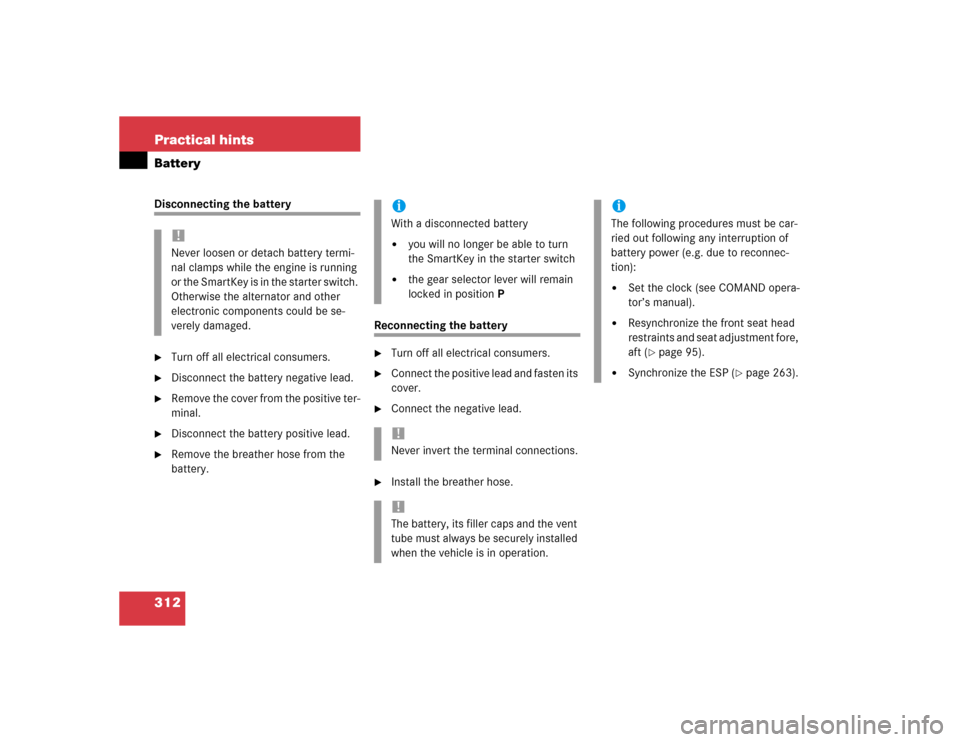
312 Practical hintsBatteryDisconnecting the battery�
Turn off all electrical consumers.
�
Disconnect the battery negative lead.
�
Remove the cover from the positive ter-
minal.
�
Disconnect the battery positive lead.
�
Remove the breather hose from the
battery.
Reconnecting the battery�
Turn off all electrical consumers.
�
Connect the positive lead and fasten its
cover.
�
Connect the negative lead.
�
Install the breather hose.
!Never loosen or detach battery termi-
nal clamps while the engine is running
or the SmartKey is in the starter switch.
Otherwise the alternator and other
electronic components could be se-
verely damaged.
iWith a disconnected battery�
you will no longer be able to turn
the SmartKey in the starter switch
�
the gear selector lever will remain
locked in positionP
!Never invert the terminal connections.!The battery, its filler caps and the vent
tube must always be securely installed
when the vehicle is in operation.
iThe following procedures must be car-
ried out following any interruption of
battery power (e.g. due to reconnec-
tion):�
Set the clock (see COMAND opera-
tor’s manual).
�
Resynchronize the front seat head
restraints and seat adjustment fore,
aft (
�page 95).
�
Synchronize the ESP (
�page 263).
Page 313 of 376
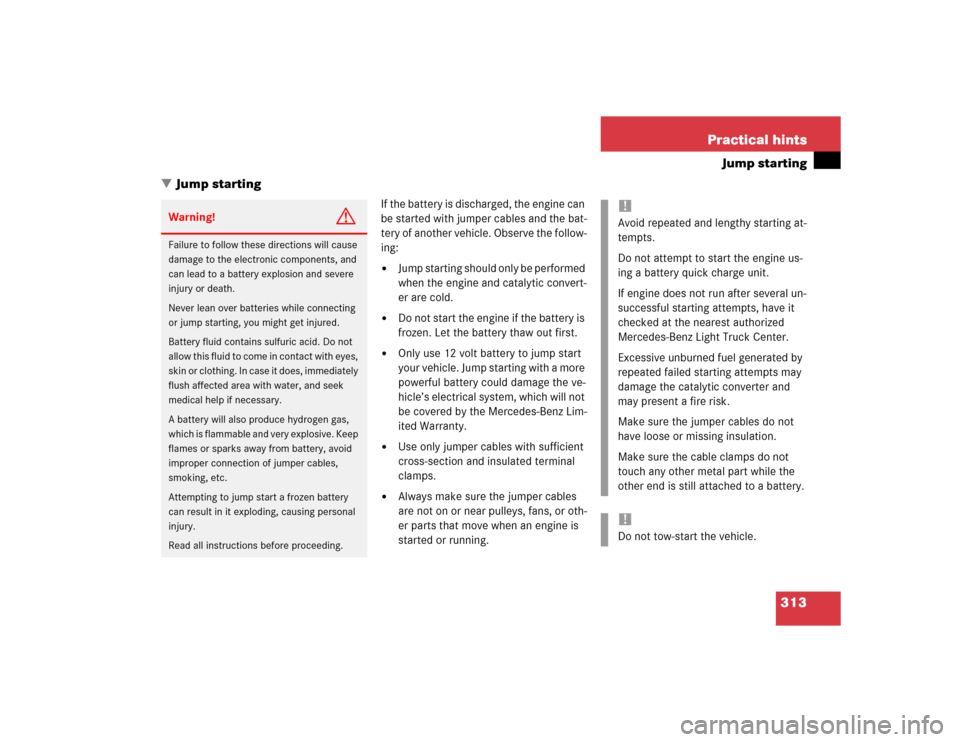
313 Practical hints
Jump starting
�Jump starting
If the battery is discharged, the engine can
be started with jumper cables and the bat-
tery of another vehicle. Observe the follow-
ing:�
Jump starting should only be performed
when the engine and catalytic convert-
er are cold.
�
Do not start the engine if the battery is
frozen. Let the battery thaw out first.
�
Only use 12 volt battery to jump start
your vehicle. Jump starting with a more
powerful battery could damage the ve-
hicle’s electrical system, which will not
be covered by the Mercedes-Benz Lim-
ited Warranty.
�
Use only jumper cables with sufficient
cross-section and insulated terminal
clamps.
�
Always make sure the jumper cables
are not on or near pulleys, fans, or oth-
er parts that move when an engine is
started or running.
Warning!
G
Failure to follow these directions will cause
damage to the electronic components, and
can lead to a battery explosion and severe
injury or death.
Never lean over batteries while connecting
or jump starting, you might get injured.
Battery fluid contains sulfuric acid. Do not
allow this fluid to come in contact with eyes,
skin or clothing. In case it does, immediately
flush affected area with water, and seek
medical help if necessary.
A battery will also produce hydrogen gas,
which is flammable and very explosive. Keep
flames or sparks away from battery, avoid
improper connection of jumper cables,
smoking, etc.
Attempting to jump start a frozen battery
can result in it exploding, causing personal
injury.
Read all instructions before proceeding.
!Avoid repeated and lengthy starting at-
tempts.
Do not attempt to start the engine us-
ing a battery quick charge unit.
If engine does not run after several un-
successful starting attempts, have it
checked at the nearest authorized
Mercedes-Benz Light Truck Center.
Excessive unburned fuel generated by
repeated failed starting attempts may
damage the catalytic converter and
may present a fire risk.
Make sure the jumper cables do not
have loose or missing insulation.
Make sure the cable clamps do not
touch any other metal part while the
other end is still attached to a battery.!Do not tow-start the vehicle.
Page 314 of 376
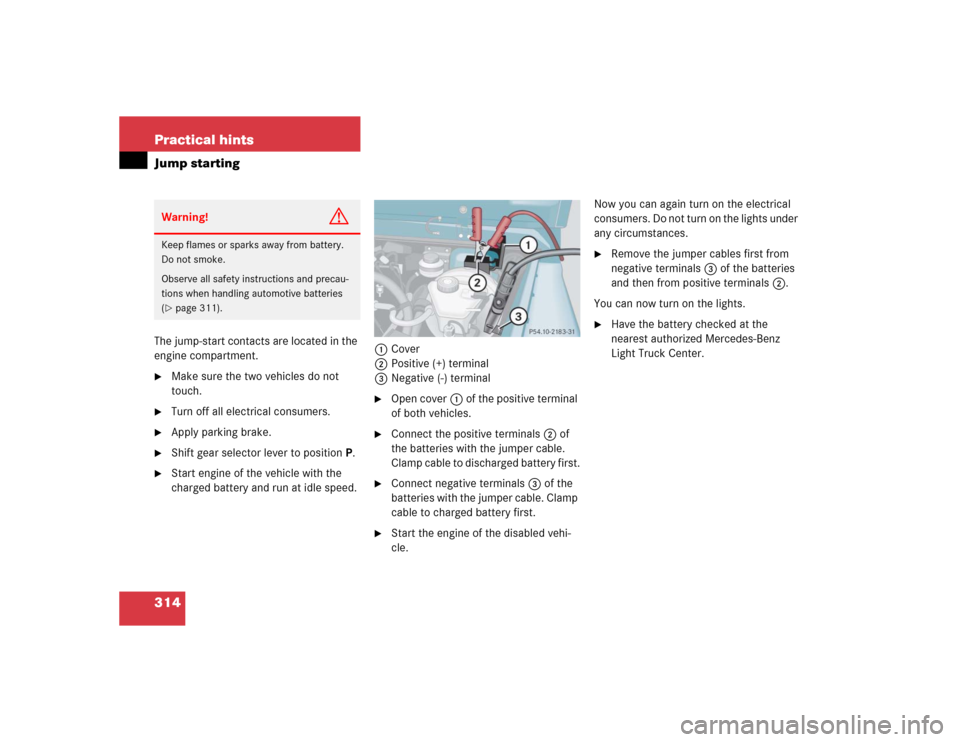
314 Practical hintsJump startingThe jump-start contacts are located in the
engine compartment.�
Make sure the two vehicles do not
touch.
�
Turn off all electrical consumers.
�
Apply parking brake.
�
Shift gear selector lever to positionP.
�
Start engine of the vehicle with the
charged battery and run at idle speed.1Cover
2Positive (+) terminal
3Negative (-) terminal
�
Open cover1 of the positive terminal
of both vehicles.
�
Connect the positive terminals2 of
the batteries with the jumper cable.
Clamp cable to discharged battery first.
�
Connect negative terminals3 of the
batteries with the jumper cable. Clamp
cable to charged battery first.
�
Start the engine of the disabled vehi-
cle.Now you can again turn on the electrical
consumers. Do not turn on the lights under
any circumstances.
�
Remove the jumper cables first from
negative terminals3 of the batteries
and then from positive terminals2.
You can now turn on the lights.
�
Have the battery checked at the
nearest authorized Mercedes-Benz
Light Truck Center.
Warning!
G
Keep flames or sparks away from battery.
Do not smoke.
Observe all safety instructions and precau-
tions when handling automotive batteries
(�page 311).
Page 316 of 376

316 Practical hintsTowing the vehicleWarning!
G
With the engine not running, there is no
power assistance for the brake and steering
systems. In this case, it is important to keep
in mind that a considerably higher degree of
effort is necessary to brake and steer the ve-
hicle. Adapt your driving accordingly.iThe gear selector lever will remain
locked in positionP and the SmartKey
will not turn in the starter switch if the
battery is disconnected or discharged.
See notes on the battery (
�page 311)
or on jump starting (
�page 313).
Manually unlocking transmission gear
selector lever (
�page 290).
iTo signal turns while being towed with
hazard warning flasher in use, turn
SmartKey in starter switch to
position2 and activate combination
switch for left or right turn signal in usu-
al manner – only the selected turn sig-
nal will operate.
Upon canceling the turn signal, the haz-
ard warning flasher will operate again.
!When towing the vehicle with all wheels
on the ground, note the following:
With the automatic central locking acti-
vated and the SmartKey in starter
switch position2, the vehicle doors
lock if the wheels are turning at vehicle
speeds of approx. 9 mph (15 km/h) or
more.
To prevent the vehicle doors from lock-
ing, deactivate the automatic central
locking (
�page 133).
Towing of the vehicle should only be
done using the towing eye. Never at-
tach tow cable, tow rope or tow rod to
vehicle chassis, frame or suspension
parts.
Page 319 of 376
319 Practical hintsFuses
�Fuses
The fuse box is located on the left side of
the cockpit in the passenger compart-
ment. It contains:�
a fuse chart
�
spare fuses
�
a special spare extractor
Additional fuses are located in:
�
battery box
�
front passenger footwell under the
cockpit
�
middle tunnel
Fuse box in passenger compartment
Opening
1Cover�
Open the driver’s door.
�
Remove cover1 in direction of ar-
rows.
Fuse box in battery box
The battery box is located under the cover
in the rear footwell.
Replacement of fuses can only be per-
formed by a Mercedes-Benz Light Truck
Center.
iOnly install fuses that have been tested
and approved by Mercedes-Benz and
that have the specified amperage rat-
ing.
Never attempt to repair or bridge a
blown fuse. Have the cause determined
and remedied by an authorized
Mercedes-Benz Light Truck Center.
Page 331 of 376
331 Technical data
Electrical system
�Electrical system
G500
G55AMG
Generator (alternator)
14 V/150 A
14 V/150 A
Starter motor
12 V/1.7 kW
12 V/1.7 kW
Battery
12 V/90 Ah
12 V/90 Ah
Spark plugs
Bosch F 8 DPER
Beru 14 FGH 8 DPUR X 2
NGK PFR5R-11
Electrode gap
0.039 in (1.0 mm)
0.039 in (1.0 mm)
Tightening torque
15 – 22 lb-ft (20 – 30 Nm)
15 – 22 lb-ft (20 – 30 Nm)
Page 347 of 376
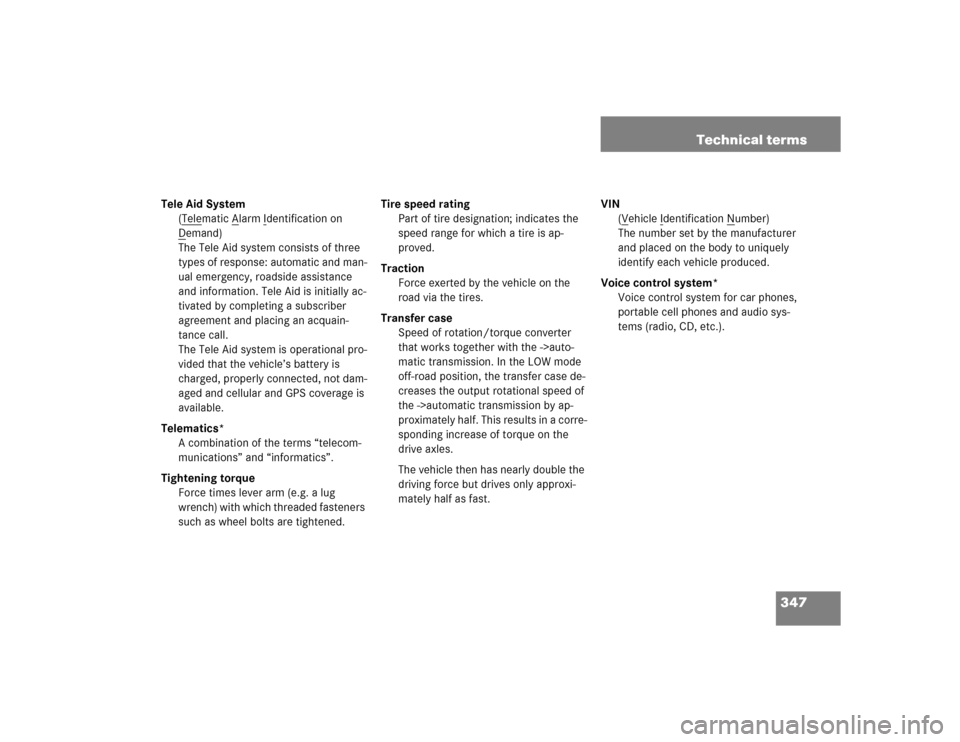
347 Technical terms
Tele Aid System
(T
elematic A
larm I
dentification on
D
emand)
The Tele Aid system consists of three
types of response: automatic and man-
ual emergency, roadside assistance
and information. Tele Aid is initially ac-
tivated by completing a subscriber
agreement and placing an acquain-
tance call.
The Tele Aid system is operational pro-
vided that the vehicle’s battery is
charged, properly connected, not dam-
aged and cellular and GPS coverage is
available.
Telematics*
A combination of the terms “telecom-
munications” and “informatics”.
Tightening torque
Force times lever arm (e.g. a lug
wrench) with which threaded fasteners
such as wheel bolts are tightened.Tire speed rating
Part of tire designation; indicates the
speed range for which a tire is ap-
proved.
Traction
Force exerted by the vehicle on the
road via the tires.
Transfer case
Speed of rotation/torque converter
that works together with the ->auto-
matic transmission. In the LOW mode
off-road position, the transfer case de-
creases the output rotational speed of
the ->automatic transmission by ap-
proximately half. This results in a corre-
sponding increase of torque on the
drive axles.
The vehicle then has nearly double the
driving force but drives only approxi-
mately half as fast.VIN
(V
ehicle I
dentification N
umber)
The number set by the manufacturer
and placed on the body to uniquely
identify each vehicle produced.
Voice control system*
Voice control system for car phones,
portable cell phones and audio sys-
tems (radio, CD, etc.).
Page 351 of 376
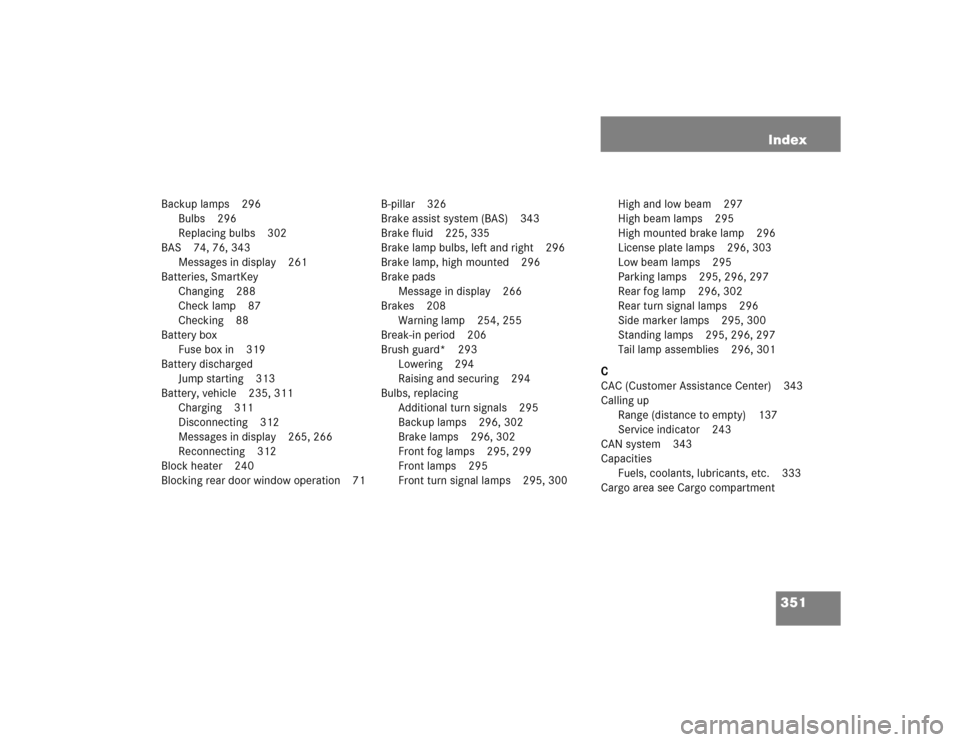
351 Index
Backup lamps 296
Bulbs 296
Replacing bulbs 302
BAS 74, 76, 343
Messages in display 261
Batteries, SmartKey
Changing 288
Check lamp 87
Checking 88
Battery box
Fuse box in 319
Battery discharged
Jump starting 313
Battery, vehicle 235, 311
Charging 311
Disconnecting 312
Messages in display 265, 266
Reconnecting 312
Block heater 240
Blocking rear door window operation 71B-pillar 326
Brake assist system (BAS) 343
Brake fluid 225, 335
Brake lamp bulbs, left and right 296
Brake lamp, high mounted 296
Brake pads
Message in display 266
Brakes 208
Warning lamp 254, 255
Break-in period 206
Brush guard* 293
Lowering 294
Raising and securing 294
Bulbs, replacing
Additional turn signals 295
Backup lamps 296, 302
Brake lamps 296, 302
Front fog lamps 295, 299
Front lamps 295
Front turn signal lamps 295, 300High and low beam 297
High beam lamps 295
High mounted brake lamp 296
License plate lamps 296, 303
Low beam lamps 295
Parking lamps 295, 296, 297
Rear fog lamp 296, 302
Rear turn signal lamps 296
Side marker lamps 295, 300
Standing lamps 295, 296, 297
Tail lamp assemblies 296, 301
C
CAC (Customer Assistance Center) 343
Calling up
Range (distance to empty) 137
Service indicator 243
CAN system 343
Capacities
Fuels, coolants, lubricants, etc. 333
Cargo area see Cargo compartment